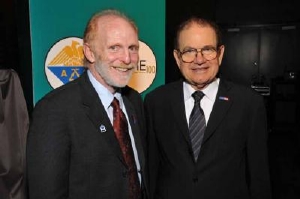Apr 9 2008
Escalating oil and gas prices along with the global challenge of climate change have spurred new generations of scientists to search for alternative energy sources. A national panel of experts on the topic gathered Monday at the 235th National Meeting in New Orleans to present a comprehensive overview of the current status, limitations, and future challenges of several significant renewable energy sources.
 American Chemical Society President Bruce Bursten (left) appears with Raymond Orbach, Under Secretary for Science at the US Department of Energy, who addressed the future of alternative energy sources at the 235th national meeting in New Orleans. The symposium was a joint effort between the ACS and the American Institute of Chemical Engineers. (Credit: Courtesy of Peter Cutts)
American Chemical Society President Bruce Bursten (left) appears with Raymond Orbach, Under Secretary for Science at the US Department of Energy, who addressed the future of alternative energy sources at the 235th national meeting in New Orleans. The symposium was a joint effort between the ACS and the American Institute of Chemical Engineers. (Credit: Courtesy of Peter Cutts)
The review, which included research from multiple scientific and engineering fields, covered solar and nuclear energy, the hydrogen economy, electrical energy storage, and catalysis for transportation fuels. The symposium was a joint collaboration between the American Chemical Society (ACS) and the American Institute of Chemical Engineers (AIChE).
“Finding alternative energy sources is a multi-disciplinary effort, but if you were to pick a specific source — whether it is nuclear energy or biomass, for example — it all comes down to the field of chemistry,” said ACS President Bruce E. Bursten. “Where the ACS plays a role is informing people about the importance of chemistry, and we must also remind people of these chemistry-based issues.” Bursten co-hosted the symposium, titled “Energy Research: Future Challenges and Opportunities,” along with AIChE president Dale Keairns.
Since global energy consumption will double, and perhaps triple, by the end of the century, scientists and engineers must find ways to supply new energy in a way that minimizes release of atmospheric greenhouse gases, said Raymond L. Orbach, the keynote speaker and Under Secretary for Science at the U.S. Department of Energy.
To adequately meet the energy demand of the future, Orbach said, “transformational breakthroughs” are needed to provide a foundation for novel technologies. He believes major advances could be nearby because of the emergence of nanotechnology, which could lead to revolutionizing the way energy is used, stored and transmitted due to controlling matter on molecular, atomic and now quantum levels.
“Our whole present-day pattern of energy production and use goes back to two key inventions in the 1870s: the incandescent light bulb and the internal combustion engine,” Orbach said. Although the light bulb was a revolutionary invention in 1879, today it is a symbol for inefficiency. Only two percent of the energy in a bulb emerges as light; the remaining 98 is lost primarily as heat.
As inefficient as the light bulb is, it doesn’t compare to the underutilization of solar energy, said Nathan S. Lewis, Division of Chemistry and Chemical Engineering at California Institute of Technology. “Solar power today provides less than one tenth of one percent of the world’s primary energy even though more energy from sunlight strikes the Earth in one hour than all the energy consumed by global human activity in one year.” A major problem inhibiting the use of solar technology is cost, which will decrease over time. The availability of sunlight will help solar power become a viable alternative source, Lewis said.
Another intriguing source of energy is nuclear power, which accounts for 19 percent of the United States’ electricity. It is a carbon-free, pollution-free form of energy. But a controversial issue surrounding its use is spent nuclear fuel, said James B. Roberto, Deputy Director for Science and Technology at the Oak Ridge National Laboratory in Tennessee. The disposal of radioactive waste has been a source of concern, and other critics point to the possible spread of nuclear weapons as a result of the technology, Roberto said.
Other speakers at the symposium were Mildred S. Dresselhaus, Institute Professor and Professor of Physics and Electrical Engineering at Massachusetts Institute of Technology; Hector D. Abruna, Department of Chemistry and Chemical Biology at Cornell University in New York; and Bruce C. Gates, Department of Chemical Engineering and Materials Science at the University of California-Davis.